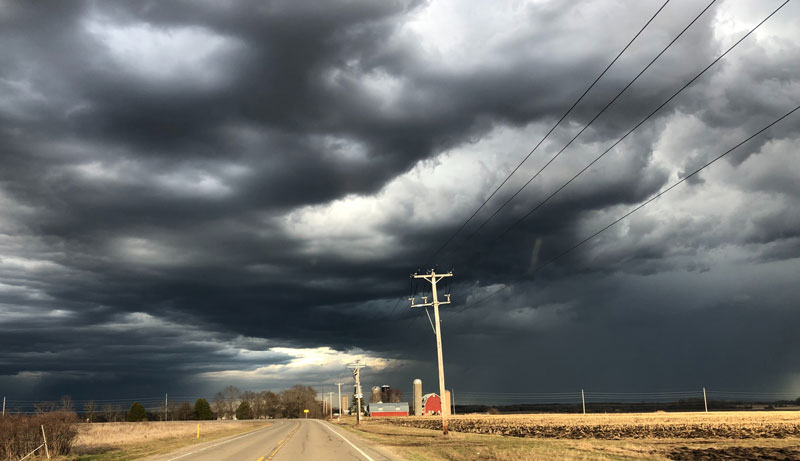Ahhhh, summer in Wisconsin… the smell of brats on the grill, the sight of boats dotting our scenic lakes, and the sound of storm sirens just when you think you’re going to settle into a nice quiet night on the deck.
Whether we like it or not, severe weather is bound to be a part of our summers here in the Midwest so we might as well be ready for it. (Hey, at least we get to freeze the other half of the year, right?) With that in mind, we’re bringing you some tips to keep in mind before, during, and after bad weather.
Before The Storm
1. Stow some storm supplies.
It’s always a good idea to be stocked up on things like fresh water, ready-to-eat food, and basic first aid supplies but thinking a little further ahead will save you a ton of stress if the power is out or you can’t make it to a store for longer than expected.
Have at least a week’s supply of prescription medications, canned food (with a can opener), gas for your generator, and a battery-powered radio to help you stay informed.
When storms are predicted in your area, make sure to have your cell phone and other rechargeable devices you might need fully charged.
2. Be ready for emergency spending.
Have some cash tucked away somewhere safe in case of an extended power outage in your area. Your local store will appreciate that you came prepared if the card machine stops working.*
For emergencies where your deposits might be delayed (either by your employer or because your credit union or bank are recovering from storm damage) having an emergency credit card with plenty of spending room is a great safety net until things are back up and running.
3. Make a plan (and practice it).
Figure out the best place to take shelter at home (or at work) and talk about it with the people in your household or office.
If an evacuation plan is a part of your emergency prep, practice how you’ll get out (especially from the higher floors) and decide on a meet-up spot away from any danger.
Once you’ve mapped out the location, think about where you should store your emergency supplies for easy access. Last, but not least then practice your emergency plan so everyone feels prepared, not scared.
Here’s more info on how and where to seek shelter from the National Weather Service.
During the Storm
4. Pay attention to weather updates.
Listen to local radio or enable notifications through your cell provider to get the most accurate updates as the emergency progresses. If you’re caught away from home or work and a storm pops up, seek shelter wherever you are instead of trying to outrun dangerous weather. (And make sure the people you care about know they should do the same.)
5. Stay put.
Some of us (present company included) have a hard time resisting the urge to stand on the front porch and watch a storm rage. It’s thrilling, awe-inspiring, and also pretty dangerous, really. Once you’ve taken shelter, stay there until the storm is over for your own safety.
6. Conserve your power.
Reserve the battery life on your cell phone and resist the urge to doom scroll, post selfies from your storm shelter, text your ex, or anything else that’s not absolutely necessary while you’re sheltering from the storm.
If you do lose power and have to switch to a generator, power down and unplug devices you don’t need to use (it’s ok to tell your kids that that includes video games, their massaging gaming chair, the neon light that says “Gamer” and anything else they can live without) until your power is back on.
After the Storm
7. Wait for the all-clear.
Bands of storms can be wildly unpredictable, with damaging winds and even tornados developing unexpectedly. Before you peek out of your storm shelter, check the weather radar or local news if possible, to make sure it’s safe.
8. Check on your neighbors (but don’t go sightseeing).
Once you know it’s safe, check on your neighbors, especially anyone who’s elderly or might need extra help. Our friends with limited mobility may have a harder time getting to shelter or not know dangerous weather is on the way so they’ll appreciate knowing that you’re looking out for them.
Resist the urge to walk or ride too far from home to look for storm damage, though. The people dealing with fallen power lines, flooded streets, and medical emergencies can lose precious time trying to control a crowd of onlookers.
9. Don’t panic.
This is huge. After a big storm a lot of the places you rely on like your local utilities, emergency services, and the credit union may still be fielding a ton of calls from anxious and frustrated people wanting answers that might not be available just yet.
It’s natural to want to look for reassurance that you’re safe and sound after a bad storm, but if you can wait for normal services to resume, you’ll save yourself a headache and give those nice folks a chance to help the people who need them right away.
*Come to think of it, that’s always good advice.
More storm resources to check out.
Click here for more details and a Toolkit from the Wisconsin DHS.

